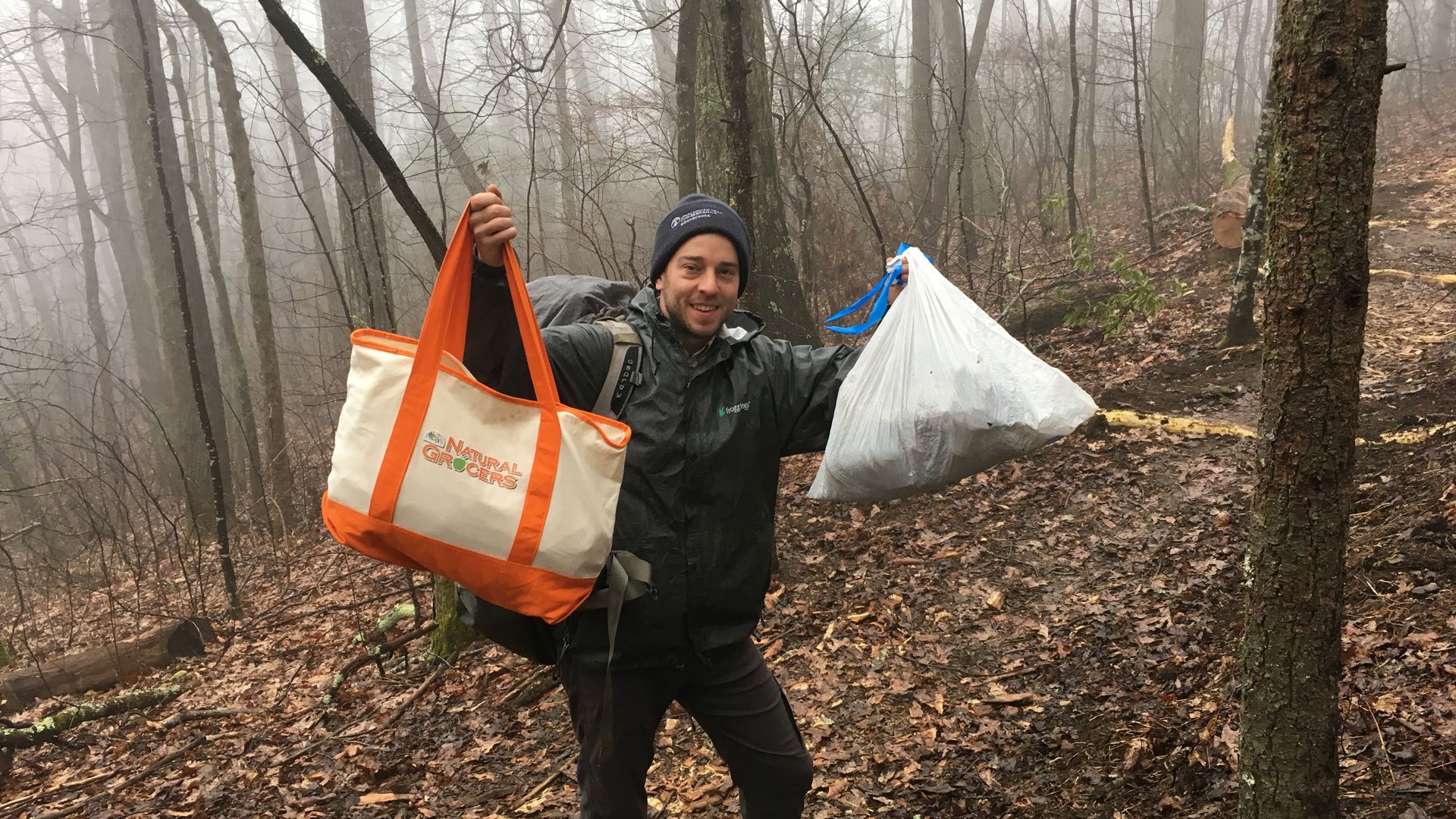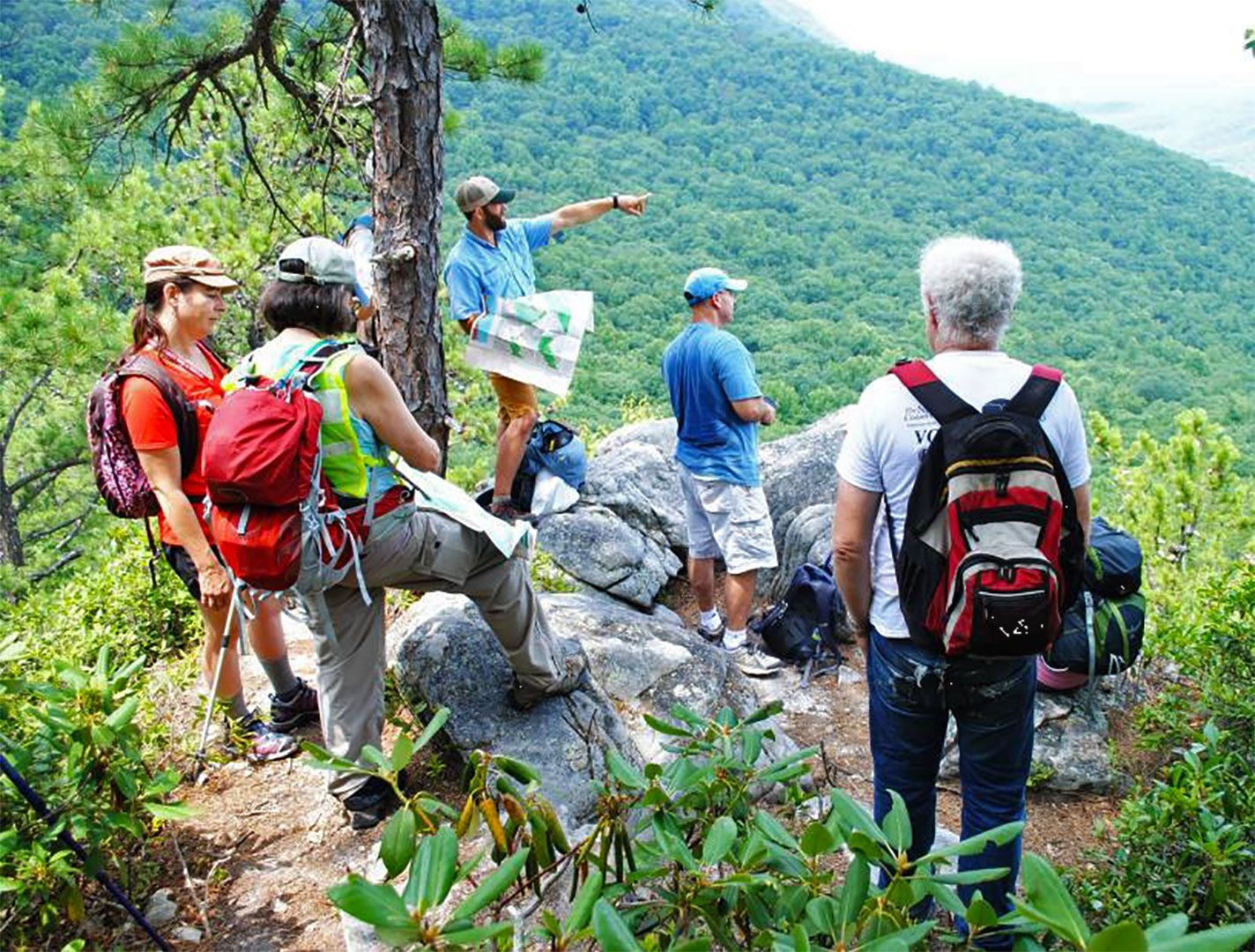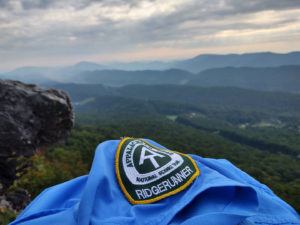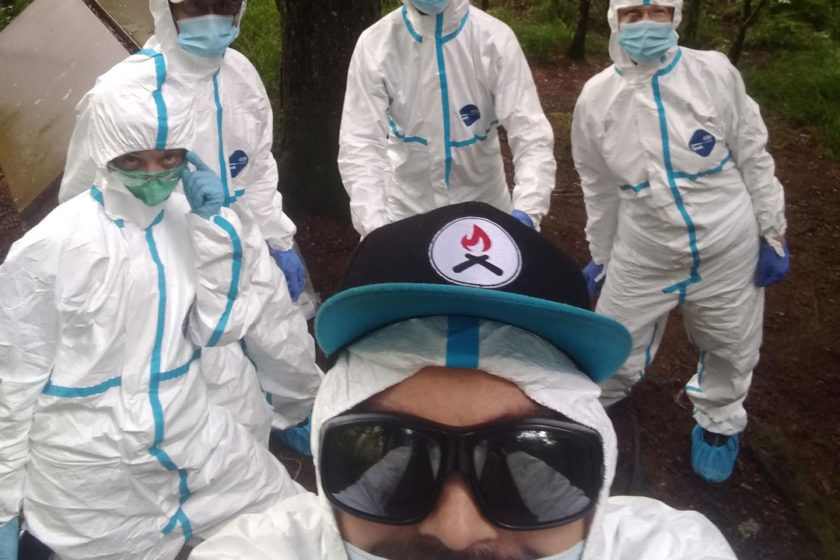By Caitlin Miller, ATC Information Services Manager
A.T. Ridgerunners: A Voice for the Trail
April 14, 2023
If you’ve hiked on the Appalachian Trail (A.T.) during its busy season, you might have crossed paths with a ridgerunner — a cheerful, Trail-tested individual who lives and works on the Trail. Ridgerunners are often met with a lot of questions about their job: Are you a ranger? Do you live out here? What do you do all day?
Let’s shed light on this important Trail job with the help of Appalachian Trail Conservancy (ATC) ridgerunners, Suzanne Neal and Jim Baum.
What do ridgerunners do all day?
As Jim puts it “I walk, and I talk.”
The primary role of a ridgerunner is to educate hikers about Leave No Trace principles, which are essential for protecting the Trail and the A.T. experience. Ridgerunners are trained experts in these principles and the management concerns for their section of the Trail.
“I often have the same conversation over and over, and it is always with the same goal in mind: that the user has the best possible outdoor experience with the least possible impact on the resource,” said Jim. “Pack it in, pack it out.”

Packing out your trash is everyone’s job, but ridgerunners remove any litter left at campsites and along the Trail so other visitors don’t think it’s okay to leave their trash behind. Photo by Laurie Potteiger.
Along with education, ridgerunners conduct Trail and overnight site maintenance. Suzanne particularly enjoys this part of being a ridgerunner because it’s “one where you get to help the forest firsthand.” Ridgerunners complete maintenance activities such as clearing downed trees along the Trail, remediating damage from fire pits, packing out trash, and — everyone’s favorite job — providing privy maintenance. Many ridgerunners can pack hundreds of pounds of bark mulch and privy equipment throughout their season.
While ridgerunners work closely with the ATC’s agency partners, including the U.S. Forest Service and National Park Service, they are not law enforcement officers or rangers. Ridgerunners are knowledgeable about the rules and regulations of their section, but don’t issue tickets or fines. Instead, ridgerunners educate hikers using a method called the “Authority of the Resource,” which means they share why these regulations are in place and how they help protect the Trail and its visitors. Through this emphasis on education and conversation, ridgerunners can connect with visitors over a shared love for the A.T. and act as a voice for the Trail.
Do ridgerunners cover the entire A.T.?
The ATC employs ridgerunners in Georgia, Great Smoky Mountains National Park, southern and central Virginia, south-central Pennsylvania, and sections of Maine. Ridgerunners employed by Trail Clubs or agency partners cover other parts of the Mid-Atlantic and New England. Not every section of the Trail has ridgerunners, however. Priority is given to the Trail’s most popular areas during periods of peak use, as well as areas along the Trail where the surrounding environment has been impacted by visitors. These include sensitive riparian zones along rivers and areas with a high concentration of threatened or endangered plants.
Suzanne points out the high use at McAfee Knob, one of the Trail’s most popular vistas.
“I sometimes talk to as many as 300 visitors in a weekend,” she said. “I try to have a meaningful interaction with every person, slipping in a bit of Leave No Trace education as much as I can.”

An A.T. ridgerunner helps identify key landmarks in the Catawba Valley near Tinker Cliffs in Virginia.
ATC ridgerunners also work closely with the local Trail Clubs to assist with Trail and shelter work. Some volunteers, like the Trail Ambassadors at Max Patch, spend a day at a time at high-use spots along the Trail educating visitors and assisting other management efforts. If you’re not ready to switch careers to become a full-time ridgerunner but love to talk about Leave No Trace, volunteering in one of these positions is a great alternative. Be sure to also check with your local A.T. Club — there are similar positions all along the Trail.
A few high-use campsites and shelters along the Trail have a resident caretaker rather than a ridgerunner. Caretakers perform similar tasks to ridgerunners but return to the same site each night instead of camping at a different place along their section of the Trail.
Why do we need ridgerunners?
When asked this question, I like to think of calling a customer service line: my experience is infinitely better when I can speak with a real person rather than try to navigate a pre-recorded menu.
Ridgerunners are an important part of the Cooperative Management System because of their ability to work with visitors face-to-face — while the ATC, Trail Clubs, and land managing agencies along the Trail provide tons of information about Leave No Trace and Trail stewardship, posting that information online or at kiosks will never be as effective for visitors as having a conversation with a helpful, knowledgeable human being. The ability of ridgerunners to mitigate resource damage at the high-use, sensitive areas they patrol cannot be overstated, and it is all done by making connections.
“My favorite part of being a ridgerunner is getting to interact with so many wonderful people,” said Jim. “Thru-hikers, section hikers, day hikers, Trail Crews, Trail Clubs, section maintainers, Forest Service employees, state park staff, the National Park Service and, of course, the wonderful folks at the ATC regional office.”
Suzanne agrees that interacting with visitors and helping them understand more about the A.T. is a highlight of being a ridgerunner. “I love teaching people about how to care for the Trail,” she said.
Beyond conversations, ridgerunners educate through their actions. Every time a hiker comes up to a ridgerunner sawing through a blowdown, clearing out a fire ring, or even setting up their tent at night, there is an opportunity for further education about Trail conservation and recreating responsibly on the A.T. and beyond.
A great example is teaching hikers about how best to protect wildlife that call the Trail home. “The area where I’m stationed has experienced bear issues in the past, so food storage is an item I discuss frequently with guests,” said Jim.
The knowledge ridgerunners provide is also tailored for the area and time of year when they are interacting with hikers. In the early spring, Georgia ridgerunners help aspiring thru-hikers adapt to life on the Trail. Ridgerunners in the Smokies note upcoming vistas and provide tips for dealing with quickly-changing weather conditions. Later this season, ridgerunners in the Mid-Atlantic will help hikers find the next flowing water source, and others in New England will recommend low-impact swimming spots and provide information about regulations in special places like Baxter State Park.
“At the beginning of [the 2021] season, I met a northbound thru-hiker on McAfee Knob,” Suzanne recalls about one of her most memorable interactions with a hiker. “We talked a long time about her plans to hike north to Maine, turn around and then hike back to Georgia. Later, close to the end of my season, I was sitting on McAfee Knob eating dinner and here comes that same thru-hiker from the beginning of the season, this time heading south. She had made it to Maine and back. We now keep in touch via social media. That’s the type of Trail magic we ridgerunners live for.”
Of course, the best way to learn about what ridgerunners do and why they’re so important to the A.T. is to talk to them yourself. This hiking season, be sure to keep an eye out for your local ridgerunner and say “Hello!” if your paths cross.
Your donation to the ATC directly supports our ridgerunner program, ensure they are on the ground every year to support hikers and care for the A.T.
Does being a ridgerunner sound like the job for you? The ATC is hiring a Cumberland Valley Ridgerunner in Pennsylvania, and ATC partners are hiring ridgerunners in Shenandoah National Park, Maryland, Pennsylvania, New Jersey, Connecticut, Massachusetts, Vermont, and Maine. Visit our Careers page for more information and to apply.
Special thanks to returning ATC ridgerunners Jim Baum and Suzanne Neal for their help with this article.










